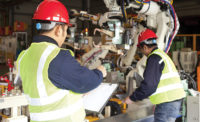Amputations, fractured fingers, second-degree burns and head trauma are just some of the serious injuries suffered by U.S. meat plant workers every week, according to data seen by the Guardian and the Bureau of Investigative Journalism.
U.S. meat workers are already three times more likely to suffer serious injury than the average American worker, and pork and beef workers nearly seven times more likely to suffer repetitive strain injuries.
And some fear that plans to remove speed restrictions on pig processing lines – currently being debated by the government – will only make the work more difficult.
Government and industry bodies point out that there have been reductions in worker injury rates over the last couple of decades, although the figures still remain higher than average. They argue that despite the lifting of speed restrictions, the need to adhere to strict rules on food safety will impose its own limit on line speeds.
Records compiled by OSHA reveal that, on average, there are at least 17 “severe” incidents a month in US meat plants. These injuries are classified as those involving “hospitalizations, amputations or loss of an eye”.
Amputations happen on average twice a week, according to the data. There were 270 incidents in a 31-month period spanning 2015 to 2017, according to the OSHA figures. Most of the incidents involved the amputation of fingers or fingertips, but there were recordings of lost hands, arms or toes. During the period there were a total of 550 serious injuries which cover 22 of the 50 states so the true total for the USA would be substantially higher.
Recorded injuries include:
- An employee’s left arm had to be surgically amputated at the shoulder after it was pulled into the cubing machine during sanitation
- A worker was reaching down to pick up a box to clear a jam when his jacket became caught in a roller. As he tried to pull it out, his hand got pulled in as well. His hand and lower arm were crushed
- While an employee was attempting to remove the ribs from the spine of a cattle rib set, his hand made contact with a running vertical band saw and two of his fingers were amputated
Chronic ailments are an even bigger issue, leaving many workers permanently disabled, and leading to losses and costs, both individually and publicly. According to one published study, carpal tunnel syndrome costs more than $2bn annually in medical treatment costs alone, for workers in all US industries.
“Every co-worker I know has been injured at some point,” plant worker Eric Fuerstenberg told the USDA as they examined the case for implementing reforms that would include speeding up the line. “I can attest that the line speeds are already too fast to keep up with. Please, I am asking you not to increase them any more.”
A meat plant worker who asked to remain anonymous told the Guardian that although he has managed to avoid injury himself, most of his friends have needed surgery at some point. “If you complain about your hands, they just say you’ll be fine … they want you to put ice on it during your break time or lunchtime” – rather than during production hours.
The 50 year-old worker, from Nebraska, adds, “When I get home I have to stretch my hands, I feel a pinch, it hurts... You never get used to the work. I do it because I have to support my family. I don’t have an education.”
Official injury rates in the meat industry have been reduced over the last 25 years after an industry and government push to improve training and guidelines. “Worker safety is considered a non-competitive issue in the meat and poultry industry,” said Eric Mittenthal, spokesman for the North American Meat Institute (NAMI), “meaning companies openly share best practices with each other at meetings throughout the year, with the goal of making our facilities as safe as possible for the people working in them.”
Training has been increased, say industry bodies, and, in a joint effort with the unions, the government and industry, a set of voluntary ergonomic guidelines for the meat packing industry has been drawn up, described by OSHA as a model for other sectors. “And these efforts have really paid off,” said Mittenthal. “In 2016 we saw all-time lows for industry injury and illness rates.”
Source The Guardian (UK) www.theguardian.com



